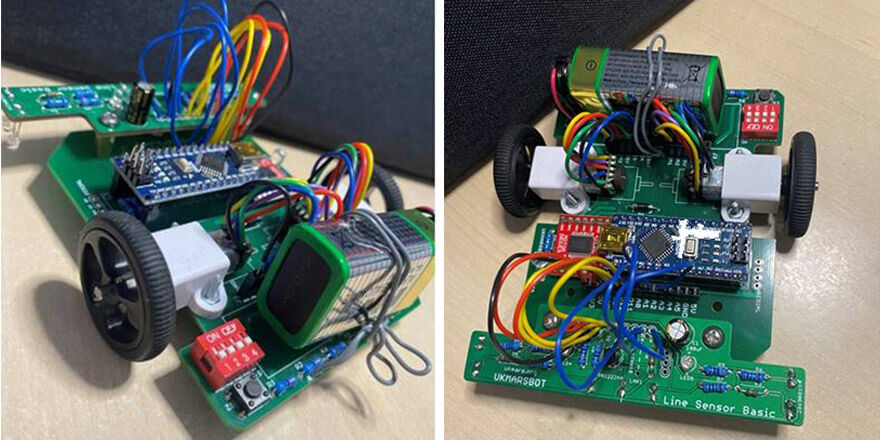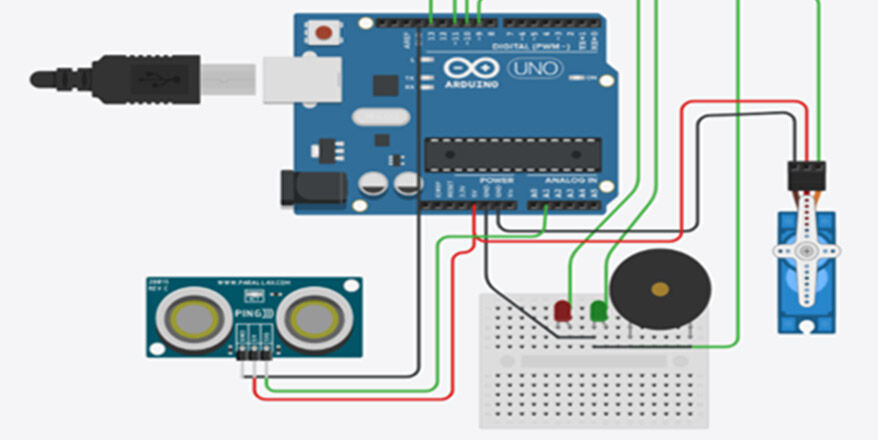Students on our BEng (Hons) Electronic Engineering course gain practical knowledge of assembling robotic and systems, and module projects allow for exciting builds. We caught up with Mohammed Hussain who tells us more about the creation of his new robot, built from components from the UKMARSBOT, which he plans take to both national and international competitions.
I've been working on a project that uses the components from the UKMARSBOT to build a functioning robot and programming it to follow a track which includes straight lines, curved turns, and cross junctions.
The UKMARSBOT is a great resource in encouraging people to become robot builders as it can be constructed by first time builders, using only basic hand tools and soldering equipment, and uses low cost and readily available materials and components.
Once it has been soldered and assembled, the Robot will be programmed using Arduino IDE software which uses C++ programming language. This process has provided me with a basic understanding of robotics and embedded systems and the project is being completed as part of my Electronics Project module this semester.
Going forward, I will be utilising the skills gained from other modules to design, build and test a sensor PCB (Printed Circuit Board). I'll construct and test an embedded controller board, debugging it using point-to-point continuity checks, providing signal checks using a multimeter and oscilloscope, and writing test routines to fully prove functionality. I have also been introduced to 3D solid modelling package for design and production via rapid prototyping.

Engineering Courses
Find out more about our courses
The aim of the Electronics Project module is to integrate skills and knowledge gained from your course into one practical project. The endpoint of this project will be a wheeled robot capable of competing in a robotic competition, with the intention of entering a national or international competition.
Knowledge gained through the previous semesters, including mathematics for signals and systems, analogue and digital electronics, and electronic engineering systems, has been essential for this project. It is also fundamental to know the basics of C programming language. If you need practice there are YouTube videos on the Arduino IDE software and it is free software available to everyone. Practice makes perfect, and this is especially true with programming. Mistakes are useful as it builds on your ability to troubleshoot and find solutions.
Staff and senior students have been really supportive throughout this project and have always been on hand to push me in the right direction with any code errors. As part of my course, I have been able to access the labs to carry out building and construction, as well PC labs where I can code and use the software.

The project has been successful so far and I’m close to being ready for the competition. The robot is fully functioning and coding is complete. The project itself has allowed me to improve my skill in soldiering, and assembling PCBs (Printed Circuit Boards) and robots. I’ve learned the fundamentals of microcontrollers, component functionality, C programming, and prototyping, through the application of mathematics and logic relating to each component. This module has developed my skills in electronic systems design, in both a technical and management capacity, which is greatly desirable by employers in a rapidly changing technological landscape.
For any students that would like to do something similar, there is a complete guide available to building the robot hardware as well as guides for all artefacts for the robot hardware, including software examples, utilities, issues log and more. Competition rules, events, dates, and registration details are also available online.
My advice would be:
- Practise! Practise! Practise!
- Make sure you stay up to date on technology news around the world as developments happen very quickly.
- Get a soldering Iron and get electronic equipment so you can practice
- Prototype making things using breadboards, components such as LED’s, buzzers, sensors etc.
- Thinker CAD can be used to create electronic circuits and Arduino prototyping.
- Look at C programming code, watch videos and get to grips with electronic systems.
- Gain an understanding of schematics of components and boards.
